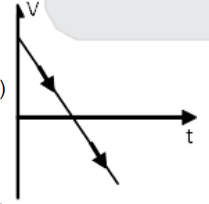Whenever a body is thrown vertically upwards with a certain velocity, the upwards motion is opposed by gravitational pull of earth and resisatnce of air. The velocity of the body goes on decreasing at a constant rate (=−g).As soon as upward velocity of body becomes zero, it cannot rise any more. The height it has attained is the maximum height. The body then begins to fall downwards with an acceleration =g.
Read the above passege and answer the following questions :
(i) A body is thrown upwards with a velocity of 19.6m/s. What is the maximum height attained?
(ii) With what velocity will the body hit the ground?
(iii) What are the implications of this study in day to day life ?
To solve the problem step by step, we will address each part of the question based on the concepts of motion under gravity.
(i) Maximum Height Attained
1. Identify the given values:
- Initial velocity (u) = 19.6 m/s
- Acceleration due to gravity (g) = 9.8 m/s² (acting downwards)
2. Use the equation of motion:
We can use the third equation of motion which relates initial velocity, final velocity, acceleration, and displacement:
v2=u2+2as
Here, at the maximum height, the final velocity (v) will be 0 m/s (the body stops rising), and the acceleration (a) will be -g (since it acts downwards).
3. Substituting the values:
0=(19.6)2+2(−9.8)(h)
Rearranging gives:
(19.6)2=2×9.8×h
4. Calculating the maximum height (h):
h=(19.6)22×9.8
h=384.1619.6=19.6 m
(ii) Velocity When Hitting the Ground
1. Understanding the motion:
When the body falls back to the ground, it will have the same speed as it was thrown upwards, due to the conservation of energy (ignoring air resistance).
2. Final velocity (v):
The velocity when it hits the ground will be equal to the initial velocity (u) but in the downward direction. Thus:
v=19.6 m/s
(iii) Implications in Day-to-Day Life
1. Understanding the concept:
The motion of the body thrown upwards and its return to the ground can be related to various life scenarios. For example, the need for an initial push or motivation to achieve goals.
2. Relating to life:
Just as the body requires an initial velocity to rise against gravity, individuals often need motivation or support to overcome challenges. The gravitational pull can symbolize obstacles or discouragements that one faces in life.
3. Conclusion:
The study of motion under gravity teaches us the importance of perseverance and the need for a strong initial push to achieve our goals, despite the challenges we may face.
- Initial velocity (u) = 19.6 m/s
- Acceleration due to gravity (g) = 9.8 m/s² (acting downwards)
We can use the third equation of motion which relates initial velocity, final velocity, acceleration, and displacement:
v2=u2+2as
Here, at the maximum height, the final velocity (v) will be 0 m/s (the body stops rising), and the acceleration (a) will be -g (since it acts downwards).
0=(19.6)2+2(−9.8)(h)
Rearranging gives:
(19.6)2=2×9.8×h
h=(19.6)22×9.8
h=384.1619.6=19.6 m
When the body falls back to the ground, it will have the same speed as it was thrown upwards, due to the conservation of energy (ignoring air resistance).
The velocity when it hits the ground will be equal to the initial velocity (u) but in the downward direction. Thus:
v=19.6 m/s
The motion of the body thrown upwards and its return to the ground can be related to various life scenarios. For example, the need for an initial push or motivation to achieve goals.
Just as the body requires an initial velocity to rise against gravity, individuals often need motivation or support to overcome challenges. The gravitational pull can symbolize obstacles or discouragements that one faces in life.
The study of motion under gravity teaches us the importance of perseverance and the need for a strong initial push to achieve our goals, despite the challenges we may face.
Topper's Solved these Questions
- GRAVIATIONBOOK - PRADEEPCHAPTER - GRAVIATIONEXERCISE - CURIOSITY QUESTION
1 Videos
- GRAVIATIONBOOK - PRADEEPCHAPTER - GRAVIATIONEXERCISE - MULTIPLE CHOICE QUESTIONS
116 Videos
- GRAVIATIONBOOK - PRADEEPCHAPTER - GRAVIATIONEXERCISE - QUESTIONS
14 Videos
- BEHAVIOUR OF PERFECT GAS & KINETIC THEORYBOOK - PRADEEPCHAPTER - BEHAVIOUR OF PERFECT GAS & KINETIC THEORYEXERCISE - Assertion - Reason Type questions
14 Videos
- KINEMATICSBOOK - PRADEEPCHAPTER - KINEMATICSEXERCISE - 1 NCERT Comprehension
4 Videos
Similar Questions
Knowledge Check
The acceleration of a body projected upwards with a certain velocity is
A9.8 ms2B−9.8ms2CzeroDinsufficient dataIf a body is thrown up with the velocity of 15 m/s then maximum height attained by the body is (g=10m/s)
A11.25mB16.2mC24.5mD7.62mA body is thrown vertically upwards which graph represents variation of velocity w.r.t time
A B
B C
C D
D
Whenever a body is thrown up with a certain velocity, the upward motion is opposed by gravitational pull of earth and also by the resistance of air.
Therefore, velocity of the body goes on decreasing.When this velocity becomes zero, the body cannot rise further. It has attained, what is called 'maximum height'. from this height, the body begins to fall downloads under the action of gravity.
Read the above passage and answer the following question:
(i)At the highest point, what are the velocity and acceleration of the body?
(ii)What is the maximum height attained by a body thrown upwards with a velocity of 19.6m/s? Take g=9.8m/s2.
(iii) What value in life do you learn from this concept ?
View SolutionA body is thrown vertically upward with a velocity of 9.8 m/s. Calculate the maximum height attained by the body. (g=9.8m/s2)
View SolutionA body is thrown vertically upward with velocity u, the greatest height h to which it will rise is
View SolutionA body is thrown vertically upwards with a velocity u . Find the true statement from the following
View SolutionA body is thrown vertically upward with velocity u, the greatest height h to which it will rise is,
View Solution
